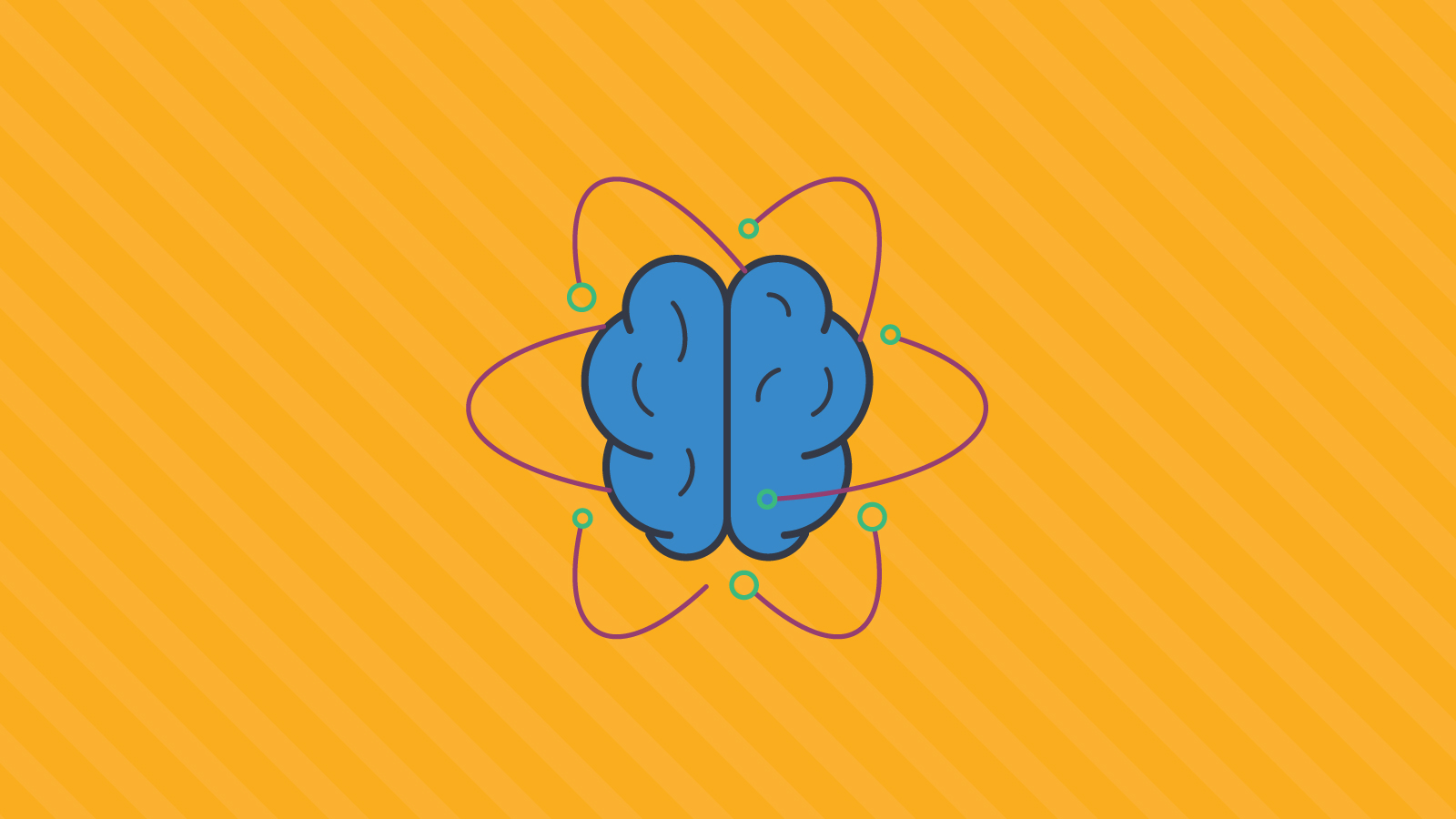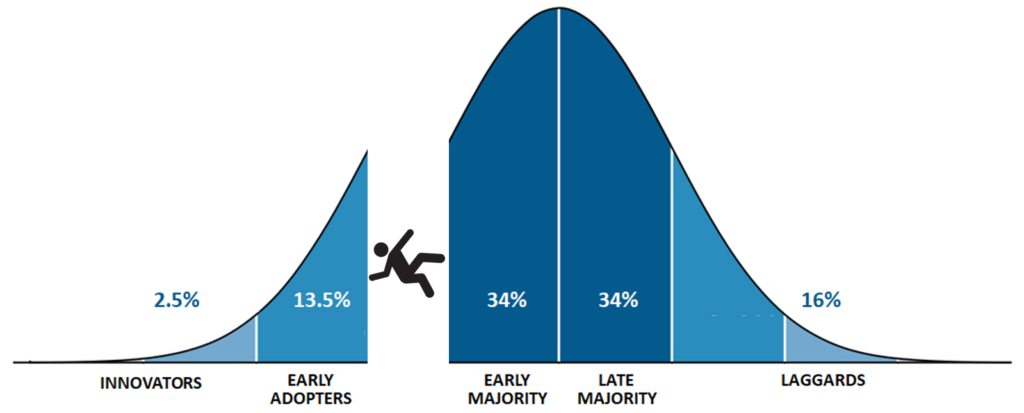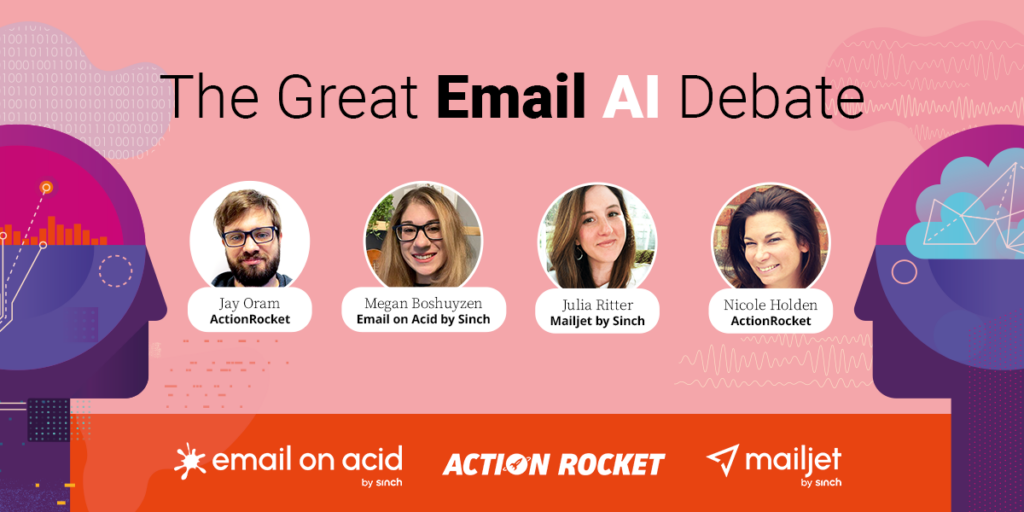Industry News
Will the Rise of ChatGPT Help Email AI Cross the Chasm?

Industry News

If you feel like society is on the edge of some sort of monumental shift in the way we work, create, and even live, you’re probably onto something. And you’re not alone. The sudden, viral rise of OpenAI’s ChatGPT is causing disruption across the tech world.
Many email marketers are also wondering how ChatGPT and technology like it will impact the way we work. Could artificial intelligence (AI) make life a little easier by helping us do our jobs more efficiently? Will email AI take over and leave us looking for a new line of work? Or is the reality of the situation somewhere in between?
The reason this feels like such a pivotal moment might be because email AI is about to “cross the chasm.” Wondering what that means? It’s all about the way different types of people adopt new technology.
There’s a theory in the tech world that’s been around since at least the 1960s called the diffusion of innovation. It’s also known as Rogers’ bell curve after the communication theorist Everett Rogers who devised the concept. The bell curve reflects the process of how different groups react to new technologies.
The process generally goes like this…
The theory is that every new technology goes through a similar adoption process. But we all know that some don’t make it. So what happens to those products?
Roger’s bell curve got a bit of an update in the early ‘90s with the release of the book “Crossing the Chasm: Marketing and Selling High-Tech Products to Mainstream Customers” by Geoffery Moore. The book presents a problem for those trying to sell innovative products to the general public when those products are new and unfamiliar.
Moore’s addition to the theory explains why many innovations die out before they’re able to reach the mainstream. There’s a gap in the cycle between the Early Adopters and the Early Majority. That’s where the idea of “crossing the chasm” comes in. Moore says you need a strong marketing strategy if you want to move a high-tech product from Early Adopters to the Early Majority. Otherwise, your big idea falls into a bottomless chasm.

Moore’s theory is that, if you want to cross the chasm, you’ve got to focus on one group of consumers at a time. That means treating them as unique audiences with their own needs, interests, and motivations for adopting an innovation.
Even the biggest tech companies fail to cross the chasm. Just look at Google. How many of us are using Google Glass right now? How’s your Google+ profile looking these days? In fact, there’s an entire Google Graveyard of dead products, many of which failed to get picked up by the mainstream public. Mark Zuckerberg’s Metaverse could be heading in the same direction. Makers of electric vehicles and virtual reality technology are also facing the challenge of crossing the chasm.
But you’ve got to admit, something seems different with the technology behind ChatGPT.
The short answer? It sure seems like ChatGPT has managed to cross the chasm, and it happened really quickly.
OpenAI launched ChatGPT on November 30, 2022. It made a lot of headlines. By the start of 2023, it seemed like everyone was talking about it. Even my 68-year-old mom was aware of ChatGPT and wondering about its implications.
Suddenly, students were using it to write papers, developers were using it to help with coding, dads were using it to feed them horribly corn jokes. And yes, email marketers were using ChatGPT too. It felt more like ChatGPT soared across the chasm rather than making a precarious leap. Why?
Good timing probably has something to do with it, and so does good marketing strategy.
The truth is, the mainstream public was well-prepared to be introduced to technology like ChatGPT. That’s thanks in part to things like Alexa, Siri, and Google Assistant as well as the many chatbots people use to interact with brands. ChatGPT felt pretty natural to use.
But the real tipping point was in the marketing of the launch. OpenAI asked everyone to test out ChatGPT. It was an open invitation to play around with the technology. That move made all of us feel like the Innovators and Early Adopters in the process.
In reality, OpenAI had plenty of people testing it out before its big release. In an interview with MIT Technology Review, employees who worked on ChatGPT claim they were shocked that the product became a viral sensation.
We were definitely surprised how well it was received. There have been so many prior attempts at a general-purpose chatbot that I knew the odds were stacked against us. However, our private beta had given us confidence that we had something that people might really enjoy.
There are two things to take note of in the quotation above that are key to ChatGPT’s seemingly sudden success:
The gaming company Sega tried to launch a VR headset in 1991 – but the timing wasn’t right, and the technology wasn’t ready. There were mp3 players and tablets before iPods and iPads came out – but Apple nailed the timing and the marketing of its products. Whether ChatGPT’s success was intentionally genius or pure luck is unclear, but it worked.
Artificial intelligence for email isn’t new either. Stil, it keeps showing up on those annual lists of emerging email marketing trends to watch. So, does email AI still need to cross the chasm? Maybe… and maybe not.
When Sinch Mailjet surveyed more than 3,000 email senders around the world, it asked respondents to select from a list of potential “advanced tactics” they planned to pursue in 2023. Only 13.7% said they planned to implement AI-powered tools.
That might seem insignificant. But there’s something interesting about that 13.7% statistic… Let’s bring the technology adoption lifecycle graphic back again.

Early adopters make up 13.5% of the public. So, if 13.7% of email senders say they’re implementing AI tools, we could make the conclusion that email AI has made it through the subset of Early adopters. Next, it needs to make the jump across that chasm into the mainstream.
Of course, email AI is a big category. You’re probably already using artificial intelligence in your daily work. If you rely on a tool like Grammarly to improve your writing, that’s AI. Conversion testing and optimization software that automatically chooses the best-performing subject line is AI. Send time optimization is a form of AI as well. And, tools like Phrasee as well as Jasper and others brought AI to email marketing years ago.
It’s fair to say that some forms of email AI have already made it into the mainstream marketing world.
So, the trail has been blazed for email AI to cross the chasm into the mainstream. And the popularity of ChatGPT is making that possibility very likely. Early adopters in the email world are already playing around with ways to use it to their advantage. That might be just the push that email marketing AI needs.
Not everyone is excited about the way email AI is accelerating. There are just as many questions and concerns as there are ideas and opportunities.
If the internet age has taught us anything, it’s that digital technology can be used for both good and evil. We can use it to enrich lives, waste lives, or destroy lives. Perhaps you’ve already heard about how scammers and spammers could use ChatGPT for email phishing operations.
Now is the time to start discussing the implications of ChatGPT, email AI, and the future of email marketing. So, that’s exactly what we’re going to do…

Join us as we partner with the team at ActionRocket for two upcoming webinars on email AI. We’ll debate the pros and cons of solutions like ChatGPT, how well they work, and what happens next.
Register for Round 1 – Marketers vs Bots:
Register for Round 2 – Email Geeks vs ChatGPT:
If you’re unable to attend either of these live events, you will still receive a link to the recorded webinar. So, sign up for The Great Email AI Debate now!